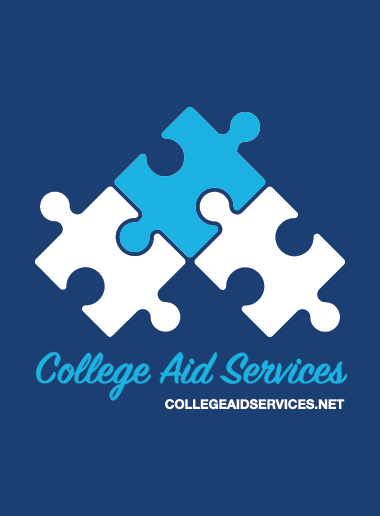How do I Apply?
Financial aid eligibility is typically determined on an annual basis so you must apply each year. The application process may vary somewhat from college to college, so you are encouraged to contact them to find out if there are additional Financial Aid applications needed to complete their process. Most schools have their requirements on their web site.
We strongly encourage all applicants for admission who are interested in being considered for financial aid to apply by the established deadline that each school has established. This is often much earlier than the date they make their decision on the school they will ultimately attend. We strongly recommend that if at all possible the parents and student complete their federal tax returns early enough to meet college deadlines, and have all income and asset information ready in preparation of completing multiple applications for financial aid considerations. It is important to note that the tax returns are from two years prior to the start of the academic year is needed for many applications while others may need it from the prior year.
The following information is provided to assist you with the financial aid application process:
- Free Application for Federal Student Aid (FAFSA) (Click here for FAFSA application on-line). This application is used to provide an Estimated Family Contribution (EFC) using family income/asset information and household size through a federal formula. The EFC determines eligibility for Federal Pell Grant, Federal loans, and Work-Study. It may also be used to determine students' eligibility for institutional grants and scholarships and private alternative loans. Deadlines vary by institution so be sure to check with those you are applying to for the required date. Students will receive a Student Aid Report (SAR) once the application is complete via email if an email address is provided and we encourage students and parents to review the SAR for accuracy.
- New York State residents who submit a FAFSA indicating attendance at a college in New York State will be prompted to complete the online TAP application by linking to it directly from your FAFSA Confirmation Page, or by going to the quick link button, Apply for TAP, on the HESC Web site: https://www.hesc.ny.gov/pay-for-college/apply-for-financial-aid/nys-tap.html . It will include pre-filled information taken from your FAFSA that will expedite the application process. If you are unable to complete the TAP application at this time you can log in to the HESC web site at a later date. You will be required to get a HESC PIN and once you have your PIN complete your TAP application. Once you have submitted your application you will be sent an email confirmation directing you to HescWeb to check the status of your award.
- Institutional Financial Aid Application. Many private colleges and universities use the College Board CSS Profile (https://cssprofile.collegeboard.org/ ) to award their institutional grants and scholarships. Others may have a supplemental form specific to their school. Be sure to check with the colleges you are applying to for any additional required forms and the deadlines for submission.
- Income Tax Information. Signed photocopies of the parents' and students' W-2 forms, 1099 forms and the federal income tax return with all pages and schedules, and/or an IRS Tax Transcript may be required. Some colleges only require this information if the applicant is selected for Verification. Check with those colleges you are applying to insure you provide them with the required information by their deadlines.
- Verification Process and the Verification Worksheet. Some schools require that all applicants and their parent(s) verify information reported on the FAFSA. The Verification Worksheet helps the Financial Aid Office collect data about your household size and number in college as well as you and your family's tax filing status. Income tax information listed above is often requested as part of the verification process. Check with those colleges you are applying to insure you provide them with the required information by their deadlines.
The Financial Aid Process At a Glance
- Complete all required financial aid application materials. Once accepted, students are sent a Financial Aid Award Letter. If not, check with the school to see if you need to complete any requirements that may be preventing them from assigning you financial aid, such as a missing document(s) from your record. The Award Letter is usually accompanied by a "package" of information that explains the awards being offered and what your next steps should be should you decide to enroll. Pay close attention to the gift aid offered (grants and scholarships) that will cover the educational expenses when comparing your award letters. Be aware of any terms and conditions associated with your awards to ensure to maintain your eligibility for them. Please note that as financial aid offices get new information, the financial aid award letter sent to you may be subject to change, in which case you should receive notification of the changes.
- Accept or decline the aid offered. Colleges may require you to sign and return the Award Letter indicating which awards you wish to accept or decline and that you understand the terms and conditions of the various awards. Other schools may send you’re their online portal for completing the acceptance process. Be certain to meet the deadlines for each college from which you are seeking financial aid.
- Complete the loan Master Promissory Note(s) and Entrance Counseling. If you have been offered a Direct Loan as part of your Financial Aid package, you will need to complete a Master Promissory Note and Entrance Counseling online. Be certain to meet the deadline the college you will be attending has set.
- Financial aid and your student (Bursar) account. Generally, the funds are credited to your student account just prior to or following the start of each semester, but until then, they may show as anticipated aid on your billing statement. Each college is a bit different and the process is usually included in the information sent with your award letter. Read this carefully so that you understand how and when your financial aid will be credited to your account.
- Excess funds and refunds. Once your student account is paid in full, and if you have a credit balance due to excess funds requested from your financial aid, you should receive a refund within14 days. Remember, if you have an outstanding balance for any educational expenses on your student account (tuition, fees, room and board) your financial aid must cover these before a refund may be issued. Each college has a unique manner in which they handle excess funds to which you may be entitled. Contact your Bursar/Student Accounts Office to ensure that you understand the process. For secure handling of refunds, if they have the option, consider signing up for direct deposit into your bank account, as well.
---------------------------------------------
|






